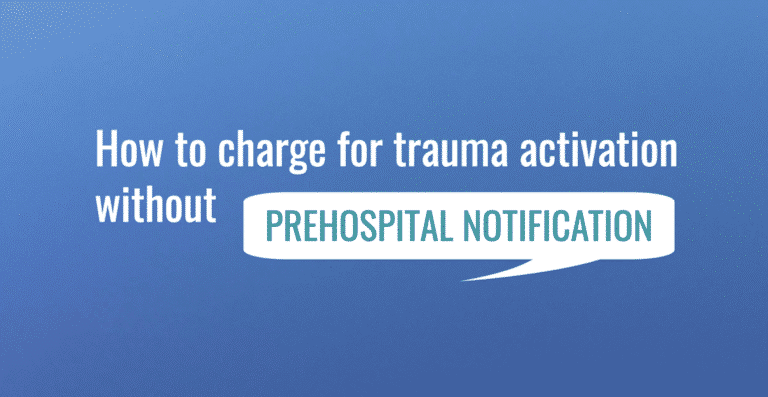Under rules from the Centers for Medicare & Medicaid Services (CMS), a trauma center cannot bill for a trauma team activation (TTA) using the revenue code UB 68x unless it has received prehospital notification of patient arrival. But according to an expert in trauma center management, there is a permissible way to charge for a trauma response without pre-notification.
This revenue cycle strategy was explained by Angie Chisolm, managing partner at Peregrine Health Services, during the recent webinar entitled “How to Get Hospital Executives to Approve More Budget for Your Trauma Program.”
“CMS rules say that you cannot use revenue code 68x, which is the trauma team activation revenue code, without pre-notification,” Chisolm said. “However, you can capture trauma activation charges under the Emergency Department revenue code.”
- “First, set up a 45x revenue code within the chargemaster,” Chisolm explained. “Then add an activation charge to that line item.”
- Label the line item “Trauma team activation w/o prenotification — full” and use the revenue code UB 450.
- Add CPT code 99291 to the charge line if the patient received at least 30 minutes of critical care by the trauma team, not just the ED physician. “This code is associated with the ED visit level, and it indicates that the patient has received at least 30 minutes of critical care,” Chisolm said.
- In addition, per CMS requirements for TTA, assign HCPCS code G0390 for trauma response team associated with hospital critical care service.
According to Chisolm, this approach allows the hospital to capture both the ED critical care charge and the trauma team activation charge.
“For example, if an ED visit level CC charge is $3,542 and the full TTA charge is $7,250, the line item on the chargemaster for ‘Trauma team activation w/o prenotification — full’ would be $10,792,” she said.
However, note that this approach only applies to TTA patients who have received at least 30 minutes of critical care.
“If the patient does not meet 30 minutes of critical care time (meaning an ED visit level 1 – 5), you simply remove the G0390 but submit the revenue code UB 68x on the claim,” Chisolm said. (For more information, read Trauma Billing: A concise guide to capturing lost charges for critical care.)
Chisolm pointed out that CMS requires hospital to apply all charges — including TTA charges — in a consistent manner.
According to the CMS Provider Reimbursement Manual, “Charges should be related consistently to the costs of the services and uniformly applied to all patients whether inpatients or outpatients.” (Part 1, Section 2202.4)
“In other words, charges should be consistently applied to all patients who receive services,” Chisolm said. “It is the coding on the claim that changes. Essentially, the coding is changed to reflect the different reporting requirements.”
Make sure trauma patients are registered correctly
Whether a trauma team activation is billed under 68x or 45x, correct patient registration is critical. Trauma leaders should work with their registration team to make sure all trauma patients are registered as Field Locator (FL) 14 patient type 5.
“Any time you launch your trauma team, you should register your patient as type 5,” Chisolm said. “And that should not matter whether you have pre-arrival notification or not.”
Understand the payer opportunities
It is important to note that charging for trauma team activation (TTA) under 45x may not necessarily lead to direct reimbursement. So what is the benefit?
“TTA charges reflected in the Hospital Cost Report can contribute to a higher case mix index, which will help increase a hospital’s overall Medicare reimbursement,” Chisolm explained.

“It is possible to get private insurers to pay for trauma services without pre-notification. The key is to negotiate a carve-out for trauma care services with each payer,” Chisolm said. “It should not matter whether you get pre-notified or not, your center is still providing that higher level of care.”
Business guidance for trauma program leaders
“How to Get Hospital Executives to Approve More Budget for Your Trauma Program” featured Eric Rhodes, president and CEO of Ascension Saint Francis in Evanston, Illinois, and Chris Stryker, chief nursing officer of UP Health System – Marquette in Marquette, Michigan.
During the webinar, the two executives shared their perspectives on how trauma program leaders can convey the value of trauma center designation to hospital administrators and secure the resources they need.
The webinar also included a special bonus session on the trauma revenue cycle. Angie Chisolm discussed how to capture trauma activation fees, charge correctly for critical care and work with finance leaders to optimize trauma program revenue.
To watch the webinar recording, click the “View Now” button below:



10 Comments
The addition of a specific 45x (450) code for patients w/o prearrival notification is questionable because the HCPCS CODE FOR ED critical care -99291- should already be used. So what HCPCS/CPT code do you use that isn’t a duplicate? Billing software will reject duplicate codes.
This constraint was put into the rules for a reason. It was suggested that hospitals would “game the system” and charge exorbitant RESPONSE (not activation) fees for walkin and patients who could be treated elsewhere such a hip fx’s. Question? Is it worth it to game the system when there is a hard rule in the Federal Register that says don’t charge trauma response fees for patients w/o pre-arrival notice? Ask about some FL hospitals about several years of scrutiny by DOJ for billing issues such as these. I’m skeptical.
Thank you for responding to the article. You bring up an excellent point that should be clarified. When billing for trauma team activations without prenotification, using the ED revenue code UB 450 is the only option. However, it should be set up correctly within the hospital chargemaster. The chargemaster should include three additional levels of service that represent the trauma team activation level, each with critical care 99291 — for example, “UB 450 99291: Full trauma team activation without prehospital notification”. This is a bundled charge on the chargemaster, not a duplicate code. This is not considered gaming the system for those patients who require trauma care but may have arrived by private vehicle with life- or limb-threatening injuries such as gunshot wounds, industrial accidents, geriatric falls on blood thinners, or pediatrics struck by auto.
The trauma RESPONSE fee is for the readiness and response of a dedicated team, not for care. If you’re not using 68x and choose to try this you may slip through the cracks under critical care. Calling it an “activation” muddies the water. You apparently are charging trauma critical care. You might rename this item in the chargemaster. TRAUMA RESPONSE is the proper term for charging for the team readiness and response. Sounds picky but charging is all about being concise.
Revenue code 068x is used for patients for whom a trauma activation occurred. CMS uses these terms interchangeably and I have not found it to cause confusion in the coding and billing of these services.
Good Morning Angie, I have a couple questions:
When using this method for billing, what exactly goes on the UB? In the article, it states you add to your CDM a line item: 450 99291 Trauma Activation without Notification $10,000
Is that how it would appear on the UB?
But the next bullet point down states to also use G0930. Are you also adding that to the UB, with zero charge? Under Rev Code 680?
How does adding revenue to a current CPT change the cost report?
Hi Jennelle,
I’m happy to help although I’m a bit confused by the question. Would you be available for a quick call?
Hi! We have our last day of ACS survey this morning, would 3:00pm PST time work? If so, email me at jennelle.nystrom@commonspirit.org
Would you be available today or tomorrow?
Angela,
Were you available for that call? If not, could you respond with exactly how the new CDM charge looks on the UB as well as how the cost report is changed by increasing charges? (Cost reports are based on the actual costs, with very little influence from charges, as I understand it.) Thank you!
Angela,
Can the FL type 5 be changed after the arrival of the patient? If they’re initially registered as “emergency”, can that be changed to “trauma” later on to meet compliance? If so, is there parameters on if it necessarily needs to be changed prior to the patient leaving the ED?